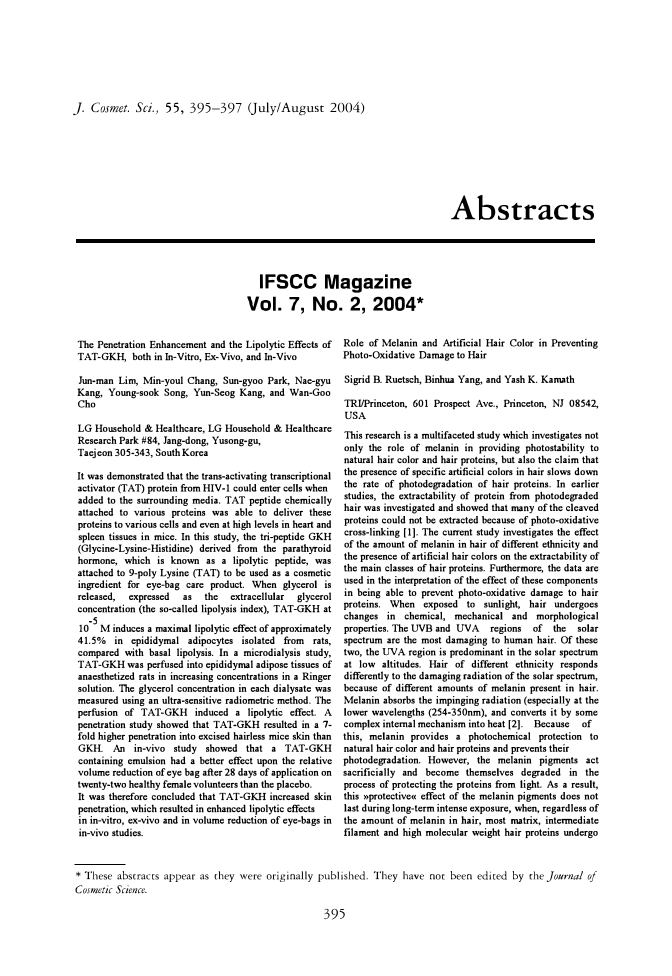394 JOURNAL OF COSMETIC SCIENCE Contribution of Encapsulation on the Biodisponibility of Retinol N. Failloux•, M.-H. Baron•, N. Abdul-Malakt, E. Perriert 0 Laboratoire de Dynamique Interactions et Reactivite, CNRS-UMR 7075, Universite Pierre et Marie Curie, 94320 Thiais, France, tcoLETICA R&D, 32, rue Saint Jean de Dieu, 69 007 Lyon, France To show the benefits of retinol encapsulation in cosmetic industry, we compared the diffusion of two different retinol preparations through skin: oil in water ( o/w) emulsions of retinol also called "free retinol" and suspension of Cylasphere ® including retinol, also called "encapsulated retinol". Two methods were used: Franz cell elucidated retinol release and storage in a hairless mouse skin according to time for the two types of preparations. The dosage of retinol by HPLC showed that encapsulated retinol was maintained into the skin for a longer time than free retinol. Raman micro spectrometry measurements established a spectral image of the skin and determined the localization of retinol. Maps were collected according to time. They detailed the shifts of free retinol and encapsulated retinol in the epidermis of a human biopsy. Spheres were smaller than droplets and they moved two times faster at this level of the skin.
]. Cosmet. Sci.) 55, 395-397 Quly/August 2004) Abstracts IFSCC Magazine Vol. 7, No. 2, 2004* The Penetration Enhancement and the Lipolytic Effects of TAT-GKH, both in In-Vitro, Ex-Vivo, and In-Vivo Jun-man Lim, Min-youl Chang, Sun-gyoo Park, Nae-gyu Kang, Young-sook Song, Yun-Seog Kang, and Wan-Goo Cho LG Household & Healthcare, LG Household & Healthcare Research Park #84, Jang-dong, Yusong-gu, Taejeon 305-343, South Korea It was demonstrated that the trans-activating transcriptional activator (TAT) protein from HIV-1 could enter cells when added to the surrounding media. TAT peptide chemically attached to various proteins was able to deliver these proteins to various cells and even at high levels in heart and spleen tissues in mice. In this study, the tri-peptide GKH (Glycine-Lysine-Histidine) derived from the parathyroid hormone, which is known as a lipolytic peptide, was attached to 9-poly Lysine (TAT) to be used as a cosmetic ingredient for eye-bag care product. When glycerol is released, expressed as the extracellular glycerol concentration (the so-called lipolysis index), TAT-GKH at -5 10 M induces a maximal lipolytic effect of approximately 41.5% in epididymal adipocytes isolated from rats, compared with basal lipolysis. In a microdialysis study, TAT-GKH was perfused into epididymal adipose tissues of anaesthetized rats in increasing concentrations in a Ringer solution. The glycerol concentration in each dialysate was measured using an ultra-sensitive radiometric method. The perfusion of TAT-GKH induced a lipolytic effect. A penetration study showed that T AT-GKH resulted in a 7- fold higher penetration into excised hairless mice skin than GKH. An in-vivo study showed that a TAT-GKH containing emulsion had a better effect upon the relative volume reduction of eye bag after 28 days of application on twenty-two healthy female volunteers than the placebo. It was therefore concluded that TAT-GKH increased skin penetration, which resulted in enhanced lipolytic effects in in-vitro, ex-vivo and in volume reduction of eye-bags in in-vivo studies. Role of Melanin and Artificial Hair Color in Preventing Photo-Oxidative Damage to Hair Sigrid B. Ruetsch, Binhua Yang, and Yash K. Karnath TRI/Princeton, 601 Prospect Ave., Princeton, NJ 08542, USA This research is a multifaceted study which investigates not only the role of melanin in providing photostability to natural hair color and hair proteins, but also the claim that the presence of specific artificial colors in hair slows down the rate of photodegradation of hair proteins. In earlier studies, the extractability of protein from photodegraded hair was investigated and showed that many of the cleaved proteins could not be extracted because of photo-oxidative cross-linking [1]. The current study investigates the effect of the amount of melanin in hair of different ethnicity and the presence of artificial hair colors on the extractability of the main classes of hair proteins. Furthermore, the data are used in the interpretation of the effect of these components in being able to prevent photo-oxidative damage to hair proteins. When exposed to sunlight, hair undergoes changes in chemical, mechanical and morphological properties. The UVB and UV A regions of the solar spectrum are the most damaging to human hair. Of these two, the UV A region is predominant in the solar spectrum at low altitudes. Hair of different ethnicity responds differently to the damaging radiation of the solar spectrum, because of different amounts of melanin present in hair. Melanin absorbs the impinging radiation (especially at the lower wavelengths (254-350nm), and converts it by some complex internal mechanism into heat [2]. Because of this, melanin provides a photochemical protection to natural hair color and hair proteins and prevents their photodegradation. However, the melanin pigments act sacrificially and become themselves degraded in the process of protecting the proteins from light. As a result, this »protective« effect of the melanin pigments does not last during long-term intense exposure, when, regardless of the amount of melanin in hair, most matrix, intermediate filament and high molecular weight hair proteins undergo * These abstracts appear as they were originally published. They have not been edited by the Journal of Cosmetic Science. 395
Purchased for the exclusive use of nofirst nolast (unknown) From: SCC Media Library & Resource Center (library.scconline.org)






































































































